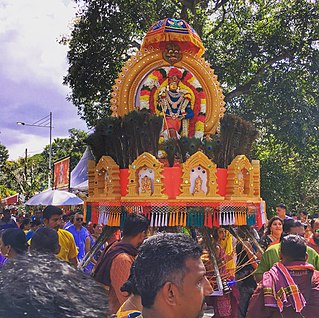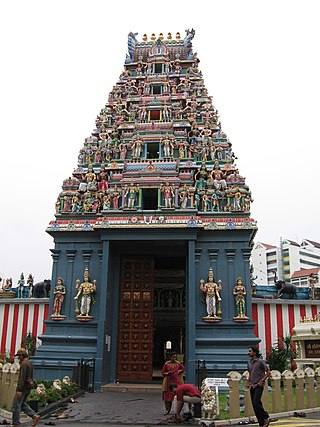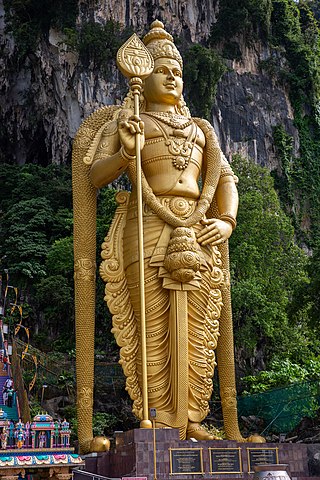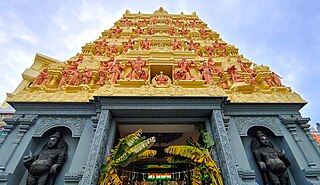
Sri Layan Sithi Vinayagar Temple is a Hindu temple at the junction of Keong Saik Road and Kreta Ayer Road in Chinatown, Singapore. Completed in 1925, the temple has been underwent multiple major renovations.

Sri Layan Sithi Vinayagar Temple is a Hindu temple at the junction of Keong Saik Road and Kreta Ayer Road in Chinatown, Singapore. Completed in 1925, the temple has been underwent multiple major renovations.
The front gate features decorated posts and a moulded cornice accompanied by dentils. The gate also features five sculptures, one of which depicts the Hindu deity Ganesha, to whom the temple is dedicated. The temple's Gopuram, which was made taller and "more ornate" during a 2007 facelift for the temple, features five levels which taper towards the top of the structure to signify the five human senses. The painted sculptures and carvings on the Gopuram depict various aspects of the mythology surrounding Ganesha. [1] The temple also features a statue of Naagar, a Holy Vel and a statue of the deity Rama. [2]
The temple replaced an older attap roof temple dedicated to Ganesha near the mortuary of the Singapore General Hospital catering towards the hospital employees, as well as those working at the nearby Outram Prison and soldiers from the Sepoy Lines. [1] However, the government acquired the land on which the temple stood in 1920 to expanding the hospital. As such, with funding from the Nattukottai Chettiars of Tamil Nadu, the current temple was built in 1925. [2] It was named "Layan Sithi" as it was located near the Sepoy Lines. [3] The statue of Ganesha from the original temple was installed in front of the main Ganesha statue within the newer temple. A third Ganesha statue was donated by Pichappa Chettiar, a trustee of the temple. [2] The temple was gazetted for conservation by the Urban Redevelopment Authority. It was placed in the Bukit Pasoh Conservation Area which is within the Chinatown Historic District. [3] The temple underwent renovations in 1975 and was re-consecrated on 14 November of that year. It was again renovated in 1989 and re-consecrated on 10 November. [4]
On the eve of Thaipusam, a statue of the Hindu deity Murugan is carried over to the temple from the Sri Thendayuthapani Temple on Tank Road on a silver chariot, where it remains until it is returned to the Sri Thendayuthapani Temple on the following night. The Holy Vel, which is, in Hindu mythology, Murugan's weapon, is transported to the temple on Tank Road on Thaipusam. [1] The Vel is doused in milk before it is offered to the Murugan statue. [2]
From June to December 2007, the temple underwent a $2.4 million facelift, during which the walls of the temple were demolished and rebuilt such that there would be more space within the temple. The temple's Gopuram, which was previously only three tiers tall, was replaced by a Gopuram with five tiers featuring carvings from 15 craftsmen of India. [5] The temple was re-consercrated on 16 December, with over 10,000 worshippers in attendance of the re-consecration ceremony. [6] In 2017, an adjacent two-storey annexe building was completed. The building was to be used for special Pujas. [4] The temple underwent a $1 million facelift in 2019. The renovation works included installing a wheelchair ramp, repainting murals and adding more cubicles to the temple's toilets. The re-consecration ceremony, which was attended by around 15,000 worshippers, was held on 15 December. [7]

Thaipusam or Thaipoosam is a Tamil Hindu festival celebrated on the first full moon day of the Tamil month of Thai coinciding with Pusam star. The festival is celebrated to commemorate the victory of Hindu god Murugan over the demon Surapadman. During the battle, Murugan is believed to have wielded a vel, a divine spear granted by his mother, Parvati.

The Sri Mariamman Temple is Singapore's oldest Hindu temple. It is an agamic temple, built in the Dravidian style. Located at 244 South Bridge Road, in the downtown Chinatown district, the temple serves the majority Hindu Singaporeans, Tamilians, in the city-state. Due to its architectural and historical significance, the temple has been gazetted a National Monument and is a major tourist attraction. Sri Mariamman Temple is managed by the Hindu Endowments Board, a statutory board under the Ministry of Community Development, Youth and Sports.

Hindu religion and culture in Singapore can be traced to the 7th century AD, when Temasek was a trading post of Hindu-Buddhist Srivijaya empire. A millennium later, a wave of immigrants from southern India were brought to Singapore, mostly as coolies and indentured labourers by the British East India Company and colonial British Empire. As with Malay peninsula, the British administration sought to stabilise a reliable labour force in its regional plantation and trading activities; it encouraged Hindus to bring family through the kangani system of migration, settle, build temples and segregated it into a community that later became Little India.

The Sri Thendayuthapani Temple, better known as the Chettiars' Temple, is one of Singapore Hindu community's most important monuments. The temple was built by the Chettiars at Tank Road in 1859 and managed by the Chettiars' Temple Society. The temple was reconstructed in 1983 and renovated in 2022. The temple was gazetted as a National monument of Singapore on 20 October 2014.

Sri Srinivasa Perumal Temple or Sri Perumal Temple is one of the oldest temples in Singapore. It is located in Little India within the planning area of Kallang along Serangoon Road, where its tall Gopuram (tower) shows the different incarnations of Lord Vishnu. This large complex, dedicated to Vishnu, dates from 1855, but the 20-metres-tall Gopuram was only built in 1966 at a cost of S$300,000. The temple's five-tier Gopuram was a donation from P. Govindasamy Pillai, one of the earliest Indian migrants to Singapore. In 1978, the temple was gazetted as a National monument of Singapore.

The Arulmigu Sri Mahamariamman Temple is a Hindu temple within George Town in the Malaysian state of Penang. The oldest Hindu temple in the state, it was built in 1833, and features sculptures of gods and goddesses over its main entrance and facade.

Keong Saik Road is a one-way road located in Chinatown within the Outram Planning Area in Singapore. The road links New Bridge Road to Neil Road, and is intersected by Kreta Ayer Road.

The Murugan Temple of North America is the first temple in the United States that is dedicated to the Hindu deity Murugan. The temple is located in Lanham, Maryland, about 5 miles (8.0 km) from Washington, D.C. Conceived in the 1980s and opened in 1999, the temple celebrates all Hindu and Tamil festivals, holidays and special occasions. In addition, the temple conducts bhajans, Tamil and religious classes. Devotees from Maryland, Washington, Virginia and throughout the country visit this traditional Saivite Hindu temple. The main sannidhi at the temple is for Murugan with Valli and Devasena. There are four other sannidhis, for Vinayaka (Ganesha), Siva, Meenakshi, Durga and Palani Aandavar.
Sri Sithi Vinayagar Temple is a Hindu temple located along Jalan Selangor in Petaling Jaya, Selangor, Malaysia. It is also generally referred to as the PJ Pillaiyar Temple. The resident deity is Ganesha in the form of Sri Sithi Vinayagar. The temple is said to be the largest temple in Malaysia dedicated to Lord Ganesha.

Sri Poyatha Moorthi Temple is the oldest existing/intact Hindu temple in Malaysia and one of the oldest functioning Hindu temples in Maritime Southeast Asia. Located in the state of Malacca, the temple is one of the few existing Chitty temples in Malaysia.

Kartikeya, also known as Skanda, Subrahmanya, Shanmukha and Murugan, among other names, is the Hindu god of war. He is generally described as the son of Shiva and Parvati and the brother of Ganesha.

Sri Krishnan Temple is a Hindu temple in Singapore. Built in 1870 and gazetted as a national monument of Singapore in 2014, it is one of Singapore's oldest temples and is the only South Indian temple in Singapore dedicated to Krishna and his consort Rukmini. The Sri Krishnan Temple and the nearby Kwan Im Thong Hood Cho Temple are known for having evolved a social practice termed "cross-worshipping", where many devotees of either temple also worship at the other. This practice is commonly seen as a microcosm of Singapore's multi-religious society.

Sri Senpaga Vinayagar Temple is a temple for the Hindu god Ganesha who is the presiding deity. It is located at Ceylon Road in Singapore.

Sri Mariamman Temple is Medan's oldest Hindu Temple. This temple was built in 1884 for the worship of Goddess Mariamman. The temple is situated in the area known as Kampung Madras or Medan's Little India. This temple is also devoted to the Hindu Gods Ganesha, and Murugan, children of Mariamman. The Gate is decorated by gopuram, namely storey tower which can usually be found at the gate of the Hindus temples in South India. The temple is a meeting point for worshippers during Thaipusam and Deevapali festivals.

The Arulmigu Balathandayuthapani Temple, also known as the Waterfall Hilltop Temple, is a Hindu temple within George Town in the Malaysian state of Penang. Dedicated to Lord Murugan, the hilltop temple, with its seven-storey 21.6 m-tall gopuram, has been touted as the largest Lord Murugan temple outside India. It is sited comparatively higher above ground than Batu Caves, with devotees having to climb over 500 steps to access the place of worship.

Muthumariamman Temple or Arulmigu Sri Muthumari Amman Kovil is a Hindu temple in Matale, Sri Lanka.

Bala Murugan Temple is a Hindu temple in Mandogalup, a suburb of Perth, Western Australia. Dedicated to the god Murugan, the temple is run by volunteers of the temple. Groundbreaking took place in 1996, and Bala Murugan Temple was completed and opened in 2008.